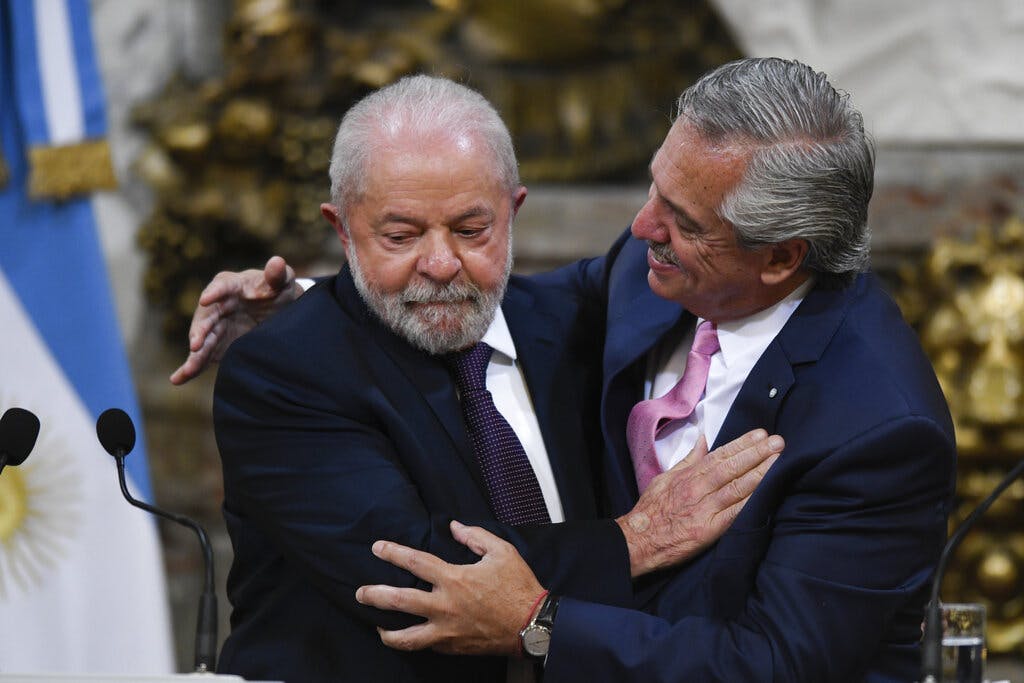Argentina, Brazil Nurse Scheme To Challenge Dollar With a New Currency
Critics in Washington and Latin America are dismissing the common currency plan hashed out by Argentina and Brazil as unworkable and damaging.

Presidents Alberto Fernandez of Argentina and Lula da Silva of Brazil will be seeking in the coming weeks to “advance discussions” to promote a “common South American currency.” Critics in Washington and Latin America, however, are dismissing the common currency plan hashed out by Argentina and Brazil as unworkable and damaging.
The currency is designed to reduce “external vulnerabilities” and serve as an alternative to the American currency, according to a statement signed by both leaders. The plan, though, could promote Communist China’s attempts to weaken the dollar’s standing as world currency, which is no doubt part of the idea.
A former American treasury secretary, Lawrence Summers, said on Twitter that the proposed plan seems “highly problematic” considering the “differences in the economies,” the history in both countries of problematic populism, the “relatively thin political connection” between them, and “both countries’ problems with fixed exchange rates.”
Messrs. Fernandez and da Silva are currently in Buenos Aires for the annual gathering of the Community of Latin American and Caribbean States, or Celac. Mr. da Silva traveled to Argentina one day early for a bilateral meeting with his Argentine counterpart. “What we want to work on now is a proposal for foreign trade and transactions between the two countries that develops in a common currency,” Mr. da Silva said Monday at Argentina’s presidential palace, known as Pink House.
Beijing has long attempted to convince countries around the world to reduce their dependence on the American greenback, in the hope that the yuan will eventually challenge the dollar as global currency. Chairman Xi is scheduled to deliver a recorded speech to the Celac leaders on Tuesday, reaffirming his 2021 cooperation agreement with the members of the organization.
Argentina’s minister of economy, Sergio Massa, tells the Financial Times that the proposed currency will be called “sur,” which means “south.” The goal, he said, is to “stimulate regional trade” and reduce the dependence on the American dollar. The currency will be offered to other countries in the region as well, with the ultimate goal of it becoming the world’s second-largest currency behind the euro.
According to the statement released by both leaders, the currency would be extended to all countries in South America, as several of them “have difficulties obtaining American dollars.” This is the case of Argentina, the president of Argentina’s General Business Confederation, Marcelo Fernandez, told the Argentinian newspaper La Nacion.
According to Mr. Marcelo Fernandez, with this agreement, Argentina would be able to finance international trade with South American countries using the new currency and saving its American dollar reserves for other trade agreements.
Yet, Argentinian economists doubt that the agreement will move forward. In 2019, Argentina’s right-wing president, Mauricio Macri, and Brazil’s Jair Bolsonaro attempted to create the “peso real.” Brazil’s Central Bank rejected the proposal under fears of Argentina’s instability. Not much has changed.
According to an Argentinian economist, Damian Falcone, Brazil will not want to move forward with the deal amid Argentina’s economic crisis. “Despite the political affinity” between Messrs. da Silva and Fernandez, he said, domestic pressures will make it difficult for Brazil’s institutions to approve the deal.
Argentina’s annual inflation rate in December was up to 94.8 percent, the highest since 1991. Its highest-denomination bill, 1,000 pesos, now fetches less than $3 in the most commonly used exchange rate.
At the moment, countries from around the world are finding alternatives to dollars to cover their debts in their local currencies. Russia has been receiving foreign payments in Russian rubles amid sanctions imposed following the invasion of Ukraine. Asia is hoping to increase the use of China’s yuan. India and the United Arab Emirates are attempting to expand their trade in Indian rupees.
According to Mr. Falcone, the world is attempting to break away from dependence on American currency as new actors, such as Communist China, try to break with America’s global dominance and create a more divided geopolitical world.
Mr. Falcone also believes that America’s inflation rate last year gave other countries in the world an opportunity to expand their trade and commercial currency alternatives.
“Increasingly, countries are encouraged to have stock reserves and trade outside of the American dollar,” Mr. Falcone tells The New York Sun.

